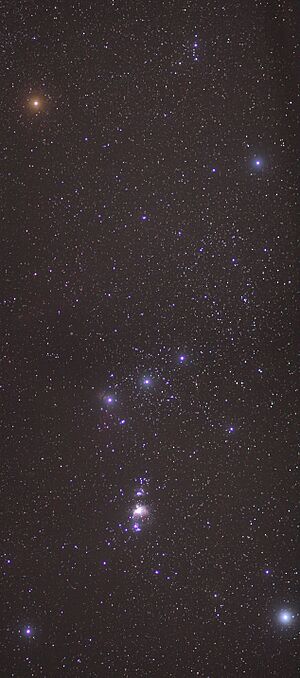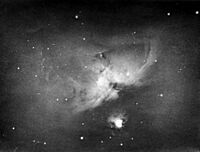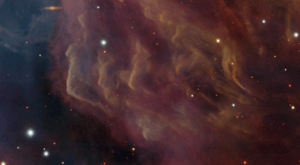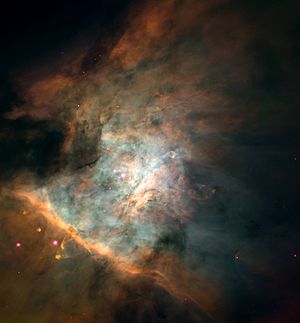Orion Nebula facts for kids
| Diffuse nebula | |
|---|---|

The entire Orion Nebula in a composite image of visible light and infrared; taken by Hubble Space Telescope in 2006
|
|
| Observation data: J2000 epoch | |
| Subtype | Reflection/Emission |
| Right ascension | 05h 35m 17.3s |
| Declination | -05° 23′ 28″ |
| Distance | 1,344±20 ly (412 pc) |
| Apparent magnitude (V) | 4.0 |
| Apparent dimensions (V) | 65×60 arcmins |
| Constellation | Orion |
| Physical characteristics | |
| Radius | 12 ly |
| Absolute magnitude (V) | — |
| Notable features | Trapezium cluster |
| Designations | NGC 1976, M42, LBN 974, Sharpless 281 |
The Orion Nebula (also known as Messier 42 or M42) is a huge cloud of gas and dust in space. It is located in our own Milky Way galaxy. You can find it south of Orion's Belt in the Orion constellation. It looks like the middle "star" in Orion's "sword."
This nebula is one of the brightest nebulae you can see. It's even visible to the naked eye on a clear night! It looks like a fuzzy patch of light. The Orion Nebula is about 1,344 ± 20 light-years (412.1 ± 6.1 pc) away from Earth. It is the closest place where many new stars are forming. This giant cloud is about 24 light-years wide. It has a mass about 2,000 times bigger than our Sun. People sometimes call it the Great Nebula in Orion.
Scientists study the Orion Nebula a lot. It helps them learn how stars and planets are born from clouds of gas and dust. Astronomers have even seen baby planets forming there. They have also seen special types of stars called brown dwarfs. The gas inside the nebula moves around a lot. Powerful light from huge stars nearby also affects it.
Contents
What is the Orion Nebula Like?
You can see the Orion Nebula without a telescope, even if there's some light pollution. It looks like a fuzzy "star" in the middle of Orion's sword. If you use binoculars or a small telescope, you can see it more clearly.
Inside the Orion Nebula is a group of very young stars. This group is called the Trapezium Cluster. It gets its name because its four main stars form a shape like a trapezoid. Two of these stars are actually double stars. This means there are six stars in total in the Trapezium Cluster. These stars are still very young. The Trapezium Cluster is part of an even bigger group of about 2,800 stars. This larger group is called the Orion Nebula cluster.
The Orion Nebula is also part of something much bigger. It's inside the Orion molecular cloud complex. This huge cloud stretches for hundreds of light-years. It covers the entire Orion Constellation. Millions of years ago, some fast-moving stars might have been born in this area.
Why Does the Orion Nebula Have Different Colors?
The Orion Nebula shines with beautiful colors: green, red, and blue-violet.
- The red color comes from hydrogen gas. It glows red when it gets energy from nearby stars.
- The blue-violet color is light from huge, hot stars. This light bounces off the dust in the nebula, making it look blue.
- The green color was a mystery for a long time! Scientists in the early 1900s thought it might be a new element. They even called it "nebulium." But later, they learned it was from oxygen atoms. These oxygen atoms glow green in the very empty space of the nebula. This kind of glow is hard to make in a lab on Earth.
How Was the Orion Nebula Discovered?
Some people think the ancient Mayans might have known about the Orion Nebula. Their creation stories talk about "Three Hearthstones" in the sky. These might match two stars in Orion and another star, with the Orion Nebula in the middle. It could have been seen as smoke from a fire.
Famous astronomers like Ptolemy and Galileo Galilei didn't write about the Orion Nebula. This is strange because they wrote about other fuzzy patches in the sky. Some scientists wonder if the nebula was not as bright back then. Maybe the stars lighting it up became brighter later.
The first person to officially discover the nebula was a French astronomer named Nicolas-Claude Fabri de Peiresc. He saw it on November 26, 1610, using a refracting telescope.
The first time someone wrote about seeing the nebula was in 1619. This was by a Jesuit astronomer named Johann Baptist Cysat. He described it as "a white light like that of a white cloud." He also noted that some stars were "compressed into a very narrow space." This might have been an early description of the Trapezium Cluster.
Many other astronomers saw the nebula after that. In 1659, a Dutch scientist named Christiaan Huygens drew the first detailed picture of its center.
Charles Messier saw the nebula on March 4, 1769. He added it to his list of deep sky objects. It was the 42nd object on his list, so it became known as M42.
In 1880, Henry Draper took the first photograph of the Orion Nebula. This was the first time anyone had ever photographed a nebula! Then, in 1883, Andrew Ainslie Common took even better photos. He used a special process and long exposures. His pictures showed stars and nebula details that the human eye couldn't see. This was a big step for astrophotography.
The Hubble Space Telescope first looked at the Orion Nebula in 1993. Since then, Hubble has taken many amazing pictures of it. These images help scientists create detailed 3D models of the nebula. They have seen baby planets forming around new stars. They also study how strong ultraviolet light from big stars affects the nebula.
In 2005, Hubble took its most detailed image of the nebula. It showed over 3,000 stars, including tiny brown dwarfs. In 2023, the James Webb Space Telescope found something new. It discovered pairs of "rogue planets" in the Orion Nebula. These planets are similar in size to Jupiter and float freely in space. Scientists call them JuMBOs (Jupiter Mass Binary Objects).
How the Orion Nebula is Shaped
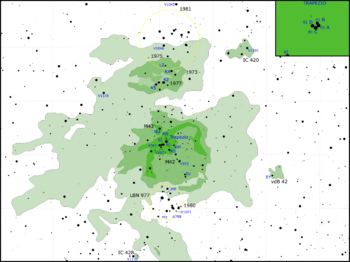
The Orion Nebula is a huge area in the sky. It includes clouds of gas and dust, groups of stars, and glowing gas. It's all part of the much bigger Orion molecular cloud complex. This complex includes other famous nebulae like Barnard's Loop and the Horsehead Nebula. New stars are forming all over this complex. Many young stars are gathered in dense groups, like the one lighting up the Orion Nebula.
Scientists believe the nebula has a large, hot, glowing gas region. This region is lit up by a very bright star called Theta1 Orionis C. This star is super powerful! The hot gas is surrounded by a cooler, denser cloud. The gas inside the nebula moves around a lot. Some parts move very fast, up to 50 kilometers per second.
Observers have given names to different parts of the Orion Nebula. The dark area that looks like a mouth is called "Sinus Magnus" or the "Fish's Mouth." The bright parts on either side are called the "Wings." Other parts are named "The Sword," "The Thrust," and "The Sail."
How Stars are Born in the Orion Nebula
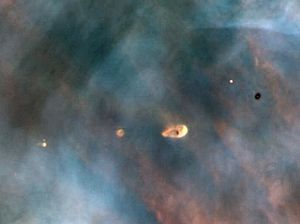
The Orion Nebula is like a "stellar nursery." This means it's a place where new stars are being born. Scientists have found about 700 stars forming inside the nebula.
In 1993, the Hubble Space Telescope made a big discovery. It found many protoplanetary disks inside the Orion Nebula. These are often called proplyds. Proplyds are clouds of gas and dust around very young stars. They are the earliest stages of solar system formation. Hubble found over 150 of them! This shows that planets forming around stars is probably very common in the universe.
Stars begin to form when clumps of gas and dust in a nebula start to pull together. This happens because of their own gravity. As the gas collapses, the center gets hotter and hotter. If it gets hot enough, a process called nuclear fusion starts. This creates a protostar. A protostar becomes a "real" star when it starts to give off enough light and heat to balance its own gravity.
Often, some gas and dust are left over around the new star. This leftover cloud forms a protoplanetary disk. This is where planets can eventually form. Recent observations show that tiny dust grains in these disks are growing. This is the first step toward making planetesimals, which are like building blocks for planets.
How Stellar Winds Affect the Nebula
Once stars are born, they send out a stream of charged particles. This is called a stellar wind. Very big stars and young stars have much stronger stellar winds than our Sun. When these winds hit the gas in the nebula, they create shock waves. These shock waves help shape the gas clouds. They also push gas clouds together, which can start the process of new star formation.
There are different kinds of shock waves in the Orion Nebula:
- Bow shocks happen when two streams of particles crash into each other. You can see them near the hottest stars.
- Jet-driven shocks come from narrow streams of material shooting out of newborn stars. These streams move very fast.
- Warped shocks look like bows. They happen when a jet-driven shock meets gas moving in a different direction.
The gas inside the Orion Nebula is always moving. It tends to flow out of the nebula towards Earth. The large cloud behind the glowing region is still shrinking due to its own gravity. Scientists have also found fast-moving "bullets" of gas shooting through the nebula. These bullets are huge, about ten times the size of Pluto's orbit. They glow with iron atoms and might have been formed by a powerful event long ago.
How the Orion Nebula Changes Over Time
Clouds like the Orion Nebula are common in galaxies like the Milky Way. They start as cold, neutral clouds of hydrogen gas. Over time, something can cause them to collapse. This might be a collision with a spiral arm of the galaxy or a shock wave from an exploding star (supernova). When this happens, the gas forms heavier molecules. This leads to stars forming inside the cloud.
The Orion Nebula is currently in this stage. New stars are still forming from the collapsing gas cloud. The youngest and brightest stars we see in the Orion Nebula are thought to be less than 300,000 years old. The very brightest ones might be only 10,000 years old!
Some of these new stars are very massive. They give off a lot of powerful ultraviolet light. The Trapezium cluster is a good example of this. Over time, this strong ultraviolet light pushes away the surrounding gas and dust. This process is called photo evaporation. It's why we can see the stars at the center of the nebula from Earth. The biggest stars have short lives and will eventually explode as supernovae.
In about 100,000 years, most of the gas and dust will be gone. What's left will be a young open cluster. This will be a group of bright, young stars with only faint wisps of the old cloud remaining.
See Also
 In Spanish: Nebulosa de Orión para niños
In Spanish: Nebulosa de Orión para niños
- Barnard's Loop
- Horsehead Nebula
- List of Messier objects
- Messier 43, which is part of the Orion Nebula
- Orion molecular cloud complex


